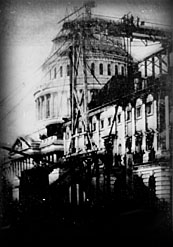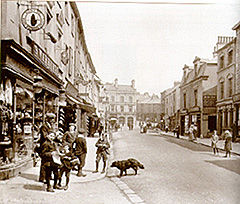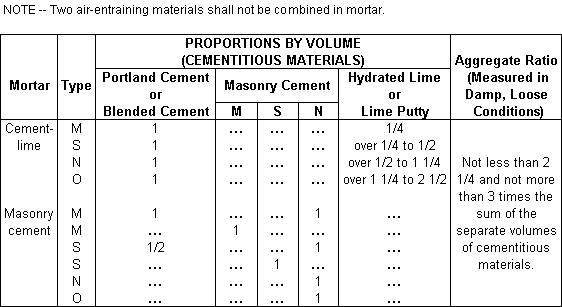
A History of Cement
Reprinted with permission from the Portland Cement Association

A History of Cement
Reprinted with permission from the Portland Cement Association
What do you think is holding the pyramids together?Cement and concrete might be synonymous as household terms, but are by nature different: cement, an ultra-fine gray powder, binds sand and rocks into a mass or matrix of concrete. Indeed, cement is the key ingredient of concrete.Semantics aside, concrete is the signature material in driveways, patios, basements, and a host of other American household items. It is also the world's most widely used building material. Annual global production of concrete hovers around 5 billion cubic yards, a volume approximated by yearly cement production levels of about 1.25 billion tons. Concrete's global appeal is not accidental - the ubiquitous, stone-like material is produced from some of the world's most abundant resources, as is cement.
Early History and Development of Portland CementEver since civilizations first started to build, we've sought a material that would bind stones into a solid, formed mass. The Assyrians and Babylonians used clay for this purpose, and the Egyptians advanced to the discovery of lime and gypsum mortar as a binding agent for building such structures as the Pyramids.The Greeks made further improvements and finally the Romans developed a cement that produced structures of remarkable durability. Most of the building foundations in the Roman Forum were constructed of a form of concrete, placed in some locations to a depth of 12 feet. The great Roman baths built about 27 B.C., the Coliseum, and the huge Basilica of Constantine are examples of early Roman architecture in which cement mortar was used.
Roman FormulaThe secret of Roman success in making cement was traced to the mixing of slaked lime with pozzolana, a volcanic ash from Mount Vesuvius. This process produced a cement capable of hardening under water. During the Middle Ages this art was lost and it was not until the scientific spirit of inquiry revived that we rediscovered the secret of hydraulic cement -- cement that will harden under water.Repeated structural failure of the Eddystone Lighthouse off the coast of Cornwall, England, led John Smeaton, a British engineer, to conduct experiments with mortars in both fresh and salt water. In 1756, these tests led to the discovery that cement made from limestone containing a considerable proportion of clay would harden under water. Making use of this discovery, he rebuilt the Eddystone Lighthouse in 1759. It stood for 126 years before replacement was necessary. Other men experimenting in the field of cement during the period from 1756 to 1830 include L. J. Vicat and Lesage in France and Joseph Parker and James Frost in England. Before portland cement was discovered and for some years after its discovery, large quantities of natural cement were used. Natural cement was produced by burning a naturally occurring mixture of lime and clay. Because the ingredients of natural cement were mixed by nature, its properties varied as widely as the natural resources from which it was made.
Aspdin Obtains PatentIn 1824, Joseph Aspdin, a bricklayer and mason in Leeds, England, took out a patent on a hydraulic cement that he called portland cement because its color resembled the stone quarried on the Isle of Portland off the British coast. Aspdin's method involved the careful proportioning of limestone and clay, pulverizing them, and burning the mixture into clinker, which was then ground into finished cement.Portland cement today, as in Aspdin's day, is a predetermined and carefully proportioned chemical combination of calcium, silicon, iron, and aluminum. |
Natural cement gave way to portland cement, which is a predictable, known
product of consistently high quality. Today, about 98 percent of the cement produced in the United States is portland cement. In Aspdin's day, however, this new product caught on slowly. Aspdin established a plant in Wakefield to manufacture portland cement, some of which was used in 1828 in the construction of the Thames River Tunnel. But it was almost 20 years later when J. D. White and Sons set up a prosperous factory in Kent that the portland cement industry saw its greatest period of early expansion, not only in England, but also in Belgium and Germany. Portland cement was used to build the London sewer system in 1859-1867. The first recorded shipment of portland cement to the United States was in 1868, when European manufacturers began shipping cement as ballast in tramp steamers at very low freight rates. The volume increased to a peak of nearly 3 million barrels in 1885. After that date, Americans began producing increasing amounts of portland cement for themselves.
History and Development of Portland Cement in
Construction of a system of canals in the first half of the 19th Century
created the first large-scale demand for cement in this country. In 1818,
a year after the Erie Canal was started, Canvass White, an engineer,
discovered rock deposits in Madison County, NY, from which natural hydraulic
cement could be made with little additional processing. He produced large
amounts of this cement for use in the Erie Canal. |

|
Mission
We work closely with government agencies in other
countries offering valuable information on masonry preservation trends,
traditional material research along with insight to old world
craftsmanship. Lecturing on history and distributing technical
information is only a first step.

|

Table from BIA TechNote 8 "Mortar for Brick Masonry"

Buckley Rumford Fireplaces
Copyright 1996 - 2001 Jim Buckley
All rights reserved.
webmaster